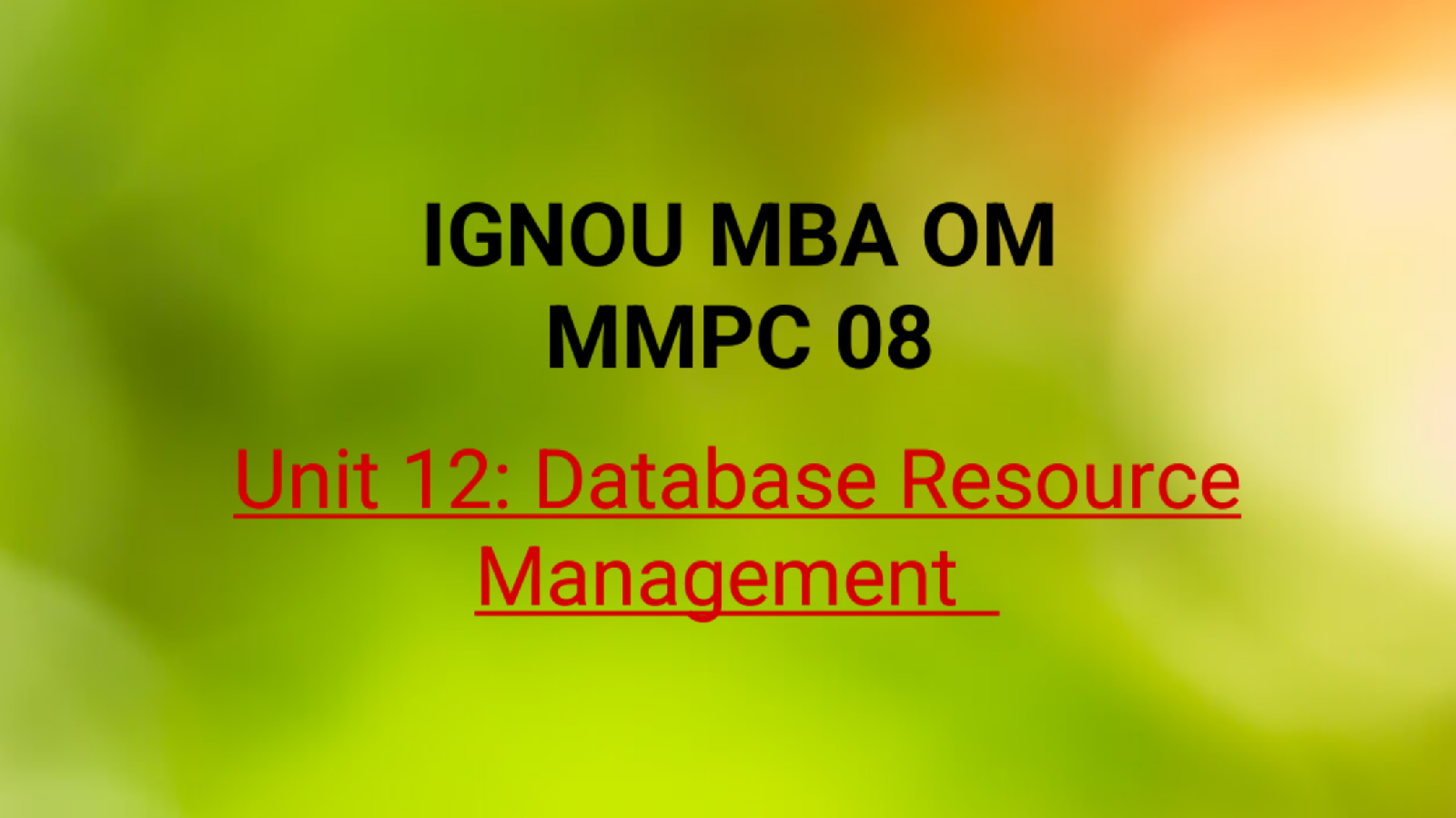IGNOU MBA MMPC-08: Information Technology for Managers
Unit 12: Database Resource Management
Introduction
Database Resource Management involves organizing, storing, and maintaining data efficiently. It ensures data integrity, security, and accessibility, which are crucial for business operations. This unit explores database fundamentals, management techniques, security measures, and optimization strategies.
1. Fundamentals of Database Management
1.1 Definition and Importance
- Database: A structured collection of data.
- Database Management System (DBMS): Software that enables users to define, manipulate, retrieve, and manage data.
- Importance: Data integrity, security, efficient retrieval, and storage.
1.2 Types of Databases
- Relational Databases (RDBMS): MySQL, PostgreSQL, Oracle.
- NoSQL Databases: MongoDB, Cassandra.
- Hierarchical Databases: IBM IMS.
- Object-Oriented Databases: db4o, ObjectDB.
1.3 Key Concepts in Database Management
- Schema: Structure of a database.
- Normalization: Process of organizing data to reduce redundancy.
- ACID Properties: Atomicity, Consistency, Isolation, Durability.
- Indexes: Speed up query execution.
2. Database Management System (DBMS) and its Components
2.1 DBMS Architecture
- Internal Level: Storage details.
- Conceptual Level: Logical structure.
- External Level: User interaction.
2.2 DBMS Functions
- Data Definition Language (DDL): CREATE, ALTER, DROP.
- Data Manipulation Language (DML): SELECT, INSERT, UPDATE, DELETE.
- Transaction Management: Ensuring data integrity during transactions.
- Concurrency Control: Managing simultaneous database access.
3. Database Security and Backup Strategies
3.1 Database Security Measures
- Authentication and Authorization: Role-based access.
- Encryption: Protects data from unauthorized access.
- Auditing and Monitoring: Logs activities for compliance.
3.2 Database Backup and Recovery
- Full Backup: Copies entire database.
- Incremental Backup: Stores changes since last backup.
- Disaster Recovery Plans: Strategies to restore data in case of failures.
4. Experiment: Creating and Managing a Database
4.1 Experiment: Creating a Table in SQL
Objective: Create a table to store customer information.
SQL Query:
CREATE TABLE Customers (
CustomerID INT PRIMARY KEY,
Name VARCHAR(50),
Email VARCHAR(100),
City VARCHAR(50)
);
4.2 Experiment: Running a Query to Retrieve Data
Objective: Fetch all customer details.
SQL Query:
SELECT * FROM Customers;
5. Assignment Questions
- Define a Database Management System (DBMS) and explain its importance.
- Describe the different types of databases with examples.
- Explain the ACID properties in database transactions.
- What are the key security measures for database management?
- Discuss the role of normalization in database management.
6. Self-Study Questions
- What is the difference between SQL and NoSQL databases?
- Explain the concept of indexing in database management.
- How does database encryption enhance security?
- What are the challenges in database resource management?
- Write a SQL query to update a customer’s email address in the Customers table.
7. Exam Questions
Short Answer Questions:
- Define normalization and its types.
- Explain the concept of transaction management in DBMS.
- What is the difference between DDL and DML?
- Mention three security measures for database protection.
- Describe the role of backup and recovery in database management.
Long Answer Questions:
- Compare and contrast relational and NoSQL databases.
- Explain the different database architectures and their functions.
- Discuss the importance of database backup strategies.
- Describe the functions and components of a DBMS.
- What are the major threats to database security, and how can they be mitigated?
Conclusion
Efficient database resource management is essential for maintaining structured, secure, and accessible data. Understanding the fundamentals of DBMS, security protocols, and optimization techniques helps businesses store and retrieve information effectively.
I have compiled the full class content for Unit 12: Database Resource Management with detailed explanations, assignments, and exam questions. Let me know if you need any modifications or additional topics!





















